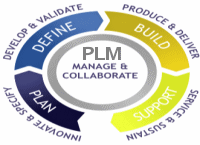 |
|||
 |
|||
| case studies | |||||||||||||||
product lifecycle management
|
|
Innovation/New Product Development
|
 |
|
|
Change Management
|
 |
|
|
Information and Intellectual Property Management
|
 |
|
|
Compliance
|
 |
|
|
Business Inefficiency
|
 |
The Solution – PLM
Through their ability to integrate all product related data and processes and to eliminate boundaries in the value chain, PLM Systems can significantly reduce non-value added activities and enable stakeholders to collaborate in real time using a consistent set of information throughout the entire product lifecycle.
As a result, productivity improvements of over 60% in NPDI-related activities have been achieved through PLM-enabled, enterprise-wide data and process optimization and integration that have allowed companies to:
- Drive innovation
- Accelerate Revenues
- Increase Productivity
- Reduce Costs
- Improve Quality
- Ensure Compliance
- Shorten Time-to-Market
In today’s highly competitive, fast-paced and
global business environment, well-designed and implemented PLM practices,
processes and technologies that support an organization’s strategies
for innovation and growth can afford companies a real competitive
advantage.

The Benefits of PLM
Using a PLM system to manage product data and integrate and automate business processes generally results in efficiency improvements, which consequently enable companies to develop more new products, shorten time-to-market, reduce costs, increase productivity and improve the quality of products and procedures.
These efficiency improvements can generally be leveraged in two ways: Increased output with the same resources (labor, time, material) or constant output with fewer resources. The result in the first case is a higher revenue at the same costs, in the latter case it is constant revenue at lower costs. In both instances the gross margin will increase as a result of using PLM.
OBEROn PLM
OBEROn provides all functionalities to develop simple
or complex PLMs. Using this platform you can define PLM object classes
(products, parts, CAD elements, ECO, ECR ... ), relationships between
them (like BOM structures), lifecycles , event rules, access rights.
OBEROn is capable of storing files (office documents, PDF, CAD drawings,
reports, images) in a distributed file system network: you can create
interfaces via webservices in order to access remote file spaces
or use the ftp protocol.
You can also define the user interfaces like menus, menu commands,
forms; these elements can be used to implement a web-browser interface
or stand-alone clients.
The OBEROn PLM is a demo web-application that demonstrates
the power of the OBEROn platform.
Here is some screenshoots that show the basic functions:

User login

The basic search: filter objects by class,code,revision,holder,current
status, creation date

Create new part: part types are subdivided into classes and sub-classes.
Specific (or Extra) attributes related to the component class/sub-class
extend the basic properties.

Show/Edit part details: a form can include also navigation items
to show connected objects (like CAD elements)

Navigate the object showing the connected elements

Show the object lifecycle and the current stage. Let the enabled
users to promote or regress the objects status.
---------------------------------------------------
REFERENCE: "What
is PLM?". PLM Technology Guide
See also
- Wikipedia: Product Lifecycle Management
- PLM Tecnology Guide: http://plmtechnologyguide.com

Please Read: Privacy Policy and Terms of Use



 Product
lifecycle management or PLM is an all-encompassing approach
for innovation, new product development and introduction (NPDI)
and product information management from ideation to end of life.
PLM Systems as an enabling technology for PLM integrate people,
data, processes, and business systems and provide a product information
backbone for companies and their extended enterprise.
Product
lifecycle management or PLM is an all-encompassing approach
for innovation, new product development and introduction (NPDI)
and product information management from ideation to end of life.
PLM Systems as an enabling technology for PLM integrate people,
data, processes, and business systems and provide a product information
backbone for companies and their extended enterprise.